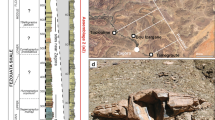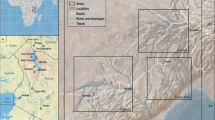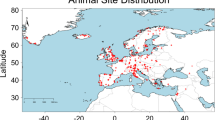Abstract
THE discovery of animal burrows in the basal beds of the main ore horizon on the Zambian Copperbelt provides evidence for the existence of metazoan life some 300 Myr older than the previously oldest known fauna, the late Proterozoic Ediacara fauna1. I describe here two kinds of burrow (referred to as types A and B pending more formal nomenclature), their geological setting, and age relationships.
This is a preview of subscription content, access via your institution
Access options
Subscribe to this journal
Receive 51 print issues and online access
$199.00 per year
only $3.90 per issue
Buy this article
- Purchase on Springer Link
- Instant access to full article PDF
Prices may be subject to local taxes which are calculated during checkout
Similar content being viewed by others
References
Glaessner, M. F., Bull. geol. Soc. Am., 82, 509–514 (1971).
Clemmey, H., in Gisements Stratiformes et Provinces Cupriferes, 255–265 (Societe Geologique De Belgique, Liege, 1974).
Cahen, L., ibid., 57–77.
Glaessner, M. F., Can. J. Earth Sci., 5, 585–590 (1968).
Hantzel, W., Treatise on invertebrate Paleontology Suppl. 1, Part W (edit. by Teichert, C.) (Geol. Soc. Am., University of Kansas, 1975).
Pryor, W. A., Bull. geol. Soc. Am., 86, 1244–1254 (1975).
Author information
Authors and Affiliations
Rights and permissions
About this article
Cite this article
CLEMMEY, H. World's oldest animal traces. Nature 261, 576–578 (1976). https://doi.org/10.1038/261576a0
Received:
Accepted:
Published:
Issue Date:
DOI: https://doi.org/10.1038/261576a0
This article is cited by
-
Small ribosomal subunit RNA sequences, evolutionary relationships among different life forms, and mitochondrial origins
Journal of Molecular Evolution (1990)
-
Mitochondrial DNA sequences of primates: Tempo and mode of evolution
Journal of Molecular Evolution (1982)
-
A meiofaunal ?thiobios? limited to the anaerobic sulfide system of marine sand does not exist
Marine Biology (1979)
-
World's oldest animal traces
Nature (1978)
-
World's oldest animal traces (reply)
Nature (1978)
Comments
By submitting a comment you agree to abide by our Terms and Community Guidelines. If you find something abusive or that does not comply with our terms or guidelines please flag it as inappropriate.



